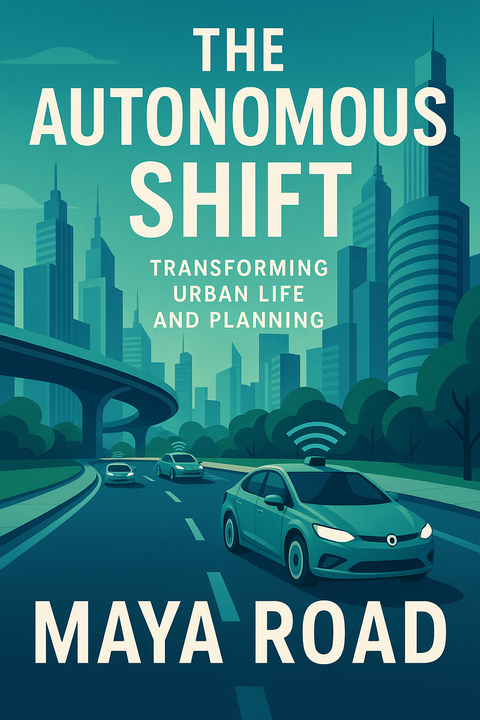
The Autonomous Shift
How Autonomous Vehicles Are Shaping Urban Planning and Everyday Life
Included:
✓ 200+ Page AI-Generated Book
✓ ePub eBook File — read on Kindle & Apple Books
✓ PDF Print File (Easy Printing)
✓ Word DOCX File (Easy Editing)
✓ Hi-Res Print-Ready Book Cover (No Logo Watermark)
✓ Full Commercial Use Rights — keep 100% of royalties
✓ Publish under your own Author Name
✓ Sell on Amazon KDP, IngramSpark, Lulu, Blurb & Gumroad to millions of readers worldwide
Introduction to the Future of Mobility
In an age where technology is reshaping the very fabric of our cities, "The Autonomous Shift" delves into the revolutionary impacts of autonomous vehicles (AVs) on urban planning and our everyday experiences. This book is designed for urban planners, transportation enthusiasts, environmentalists, and anyone curious about the future of mobility. Explore how self-driving vehicles are not just a technological innovation but a pivotal component driving transformative changes in city design and societal patterns.
The Role of Autonomous Vehicles in Urban Design
As we embark on the journey to integrate AVs into our cities, the need for innovative urban design becomes apparent. This book highlights how AVs are anticipated to reduce traffic congestion and lower private car ownership, thus freeing up valuable urban space. We analyze the exciting potential for creating parks, wider sidewalks, and bike lanes – a shift towards more human-centered urban spaces. With extensive research into the nuances of urban mobility and design, this book promises to provide readers with an in-depth understanding of what these changes mean for our cities.
Improving Safety and Sustainability
One of the critical areas of focus is on road safety and environmental sustainability. By looking into how AVs can significantly reduce emissions, especially when paired with electric vehicles, we discuss their role in fostering a cleaner environment. The book emphasizes the importance of implementing suitable regulations and frameworks to harness these advantages and ensure a safe, accessible, and sustainable urban ecosystem.
Integrating AVs with Public Transit
The integration of AVs with existing transportation systems is another focal point of discussion. This book explores shared mobility options like robo-taxis and on-demand shuttles, providing insights into how such integration can enhance public transit, increase accessibility, and meet diverse urban mobility needs. We address last-mile challenges and the solutions AVs can provide in overcoming them, creating a more interconnected transport network.
The Path Forward: Policy and Future Implications
Finally, we navigate the critical policies and frameworks necessary for the successful integration of AVs into urban life. Readers will gain a holistic understanding of the regulatory landscape while contemplating the social, economic, and environmental implications of these innovations. Each chapter is enriched with extensive research and real-world examples, ensuring that readers are well-informed and prepared for the changes ahead in urban mobility.
Table of Contents
1. Understanding Autonomous Vehicles- The Evolution of AV Technology
- Key Players in the AV Market
- Public Perception and Acceptance of AVs
2. Impact on Urban Planning
- Rethinking City Design for AV Integration
- Infrastructure Changes Required for AVs
- Creating Human-Centered Spaces
3. Safety and Sustainability Benefits
- Reducing Traffic Accidents with AVs
- Environmental Impact of AVs vs Traditional Vehicles
- Policy Implications for Safe AV Adoption
4. Integrating AVs into Public Transit Systems
- Shared Mobility Solutions: Robo-Taxis and Shuttles
- Connecting AVs with Traditional Transit
- Case Studies of Successful Integrations
5. The Future of Urban Space
- Transforming Parking Areas into Green Spaces
- Wider Sidewalks and Enhanced Public Areas
- Encouraging Active Transportation
6. Technological Innovations in AVs
- Sensor Technologies and Communication Systems
- Data Privacy and Security Concerns
- Continuous Learning and AI in AV Operation
7. Challenges and Barriers to AV Adoption
- Regulatory Challenges Affecting AV Deployment
- Legal and Insurance Implications
- Public Infrastructure Limitations
8. Economic Implications of AVs
- Cost-Benefit Analysis of AV Integration
- Impact on Job Markets and Employment
- Emerging Business Models in Urban Transportation
9. Global Perspectives on AV Implementation
- Case Studies from Leading AV Cities
- Cultural Influences on AV Acceptance
- International Regulatory Frameworks
10. Ethical Considerations in AV Development
- Decision-Making in Critical Situations
- Implications for Disadvantaged Communities
- Equity in Access to AV Technology
11. Visions for Future Cities
- Smart Cities and AV Synergy
- Community Engagement in Urban Design
- Imagining the Sustainable City of Tomorrow
12. Conclusion: The Road Ahead
- Key Findings and Insights from the Book
- Future Trends in Urban Mobility
- Call to Action for Planners and Policymakers
Target Audience
This book is aimed at urban planners, policymakers, transportation professionals, and anyone interested in understanding how autonomous vehicles will impact urban life and city design.
Key Takeaways
- Insights on how AVs are transforming urban planning and design.
- Understanding the benefits of AVs for safety and sustainability.
- Exploration of the integration of AVs with public transit.
- Real-world examples of successful AV implementations in cities.
- Future policy considerations for equitable AV adoption.
